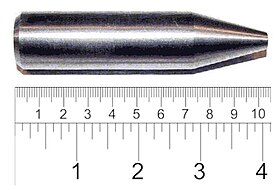
Back يورانيوم منضب Arabic Збеднены ўран Byelorussian Обеднен уран Bulgarian Urani empobrit Catalan Ochuzený uran Czech Abreicherung German Απεμπλουτισμένο ουράνιο Greek Uranio empobrecido Spanish Uranio pobretu Basque اورانیوم ضعیفشده Persian

| Part of a series on |
| Pollution |
|---|
 |
Depleted uranium (DU; also referred to in the past as Q-metal, depletalloy or D-38) is uranium with a lower content of the fissile isotope 235U than natural uranium.[2] Natural uranium contains about 0.72% 235U, while the DU used by the U.S. Department of Defense contains 0.3% 235U or less. The less radioactive and non-fissile 238U constitutes the main component of depleted uranium.
Depleted uranium is notable for the extremely high density of its metallic form: at 19.1 grams per cubic centimetre (0.69 lb/cu in), DU is 68.4% denser than lead. Civilian uses include counterweights in aircraft, radiation shielding in medical radiation therapy and industrial radiography equipment, and containers for transporting radioactive materials. Military uses include armor plating and armor-piercing projectiles.
Depleted uranium has lower mass fractions—up to three times less—of 235U and 234U than natural uranium. Since 238U has a much longer half-life than the lighter isotopes, DU is about 40% less radioactive than natural uranium.[2][3][4] Most of the alpha radiation comes from 238U and 234U[notes 1] whereas beta radiation comes from 234Th and 234Pa that are formed within a few weeks.
Most depleted uranium arises as a by-product of the production of enriched uranium for use as fuel in nuclear reactors and in the manufacture of nuclear weapons. Enrichment processes generate uranium with a higher-than-natural concentration of lower-mass-number uranium isotopes (in particular 235U, which is the uranium isotope supporting the fission chain reaction) with the bulk of the feed ending up as depleted uranium.
The use of DU in munitions is controversial because of concerns about potential long-term health effects.[5][6] Normal functioning of the kidney, brain, liver, heart, and numerous other systems can be affected by exposure to uranium, a toxic metal.[7] It is only weakly radioactive because of the long radioactive half-life of 238U (4.468 × 109 or 4,468,000,000 years) and the low amounts of 234U (half-life about 246,000 years) and 235U (half-life 700 million years). The biological half-life (the average time it takes for the human body to eliminate half the amount in the body) for uranium is about 15 days.[8] The aerosol or spallation frangible powder produced by impact and combustion of depleted uranium munitions can potentially contaminate wide areas around the impact sites, leading to possible inhalation by human beings.[9]
The actual level of acute and chronic toxicity of DU is also controversial. Several studies using cultured cells and laboratory rodents suggest the possibility of leukemogenic, genetic, reproductive, and neurological effects from chronic exposure.[5] According to an article in Al Jazeera, DU from American artillery is suspected to be one of the major causes of an increase in the general mortality rate in Iraq since 1991.[10] A 2005 epidemiology review concluded "In aggregate the human epidemiological evidence is consistent with increased risk of birth defects in offspring of persons exposed to DU."[11] A 2021 study concluded that DU from exploding munitions did not lead to Gulf War illness in American veterans deployed in the Gulf War.[12] According to a 2013 study, despite the use of DU by coalition forces in Fallujah, no DU has been found in soil samples taken from the city,[13] although another study of 2011 had indicated elevated levels of uranium in tissues of the city inhabitants.[14]
- ^ "Figure 1. DU penetrator from the A-10 30mm round". 12 April 2007. Archived from the original on 12 April 2007. Retrieved 4 September 2013.
- ^ a b Cite error: The named reference
McDiarmid 2001 123was invoked but never defined (see the help page). - ^ Sztajnkrycer, Matthew D. (March 2004). "Chemical and Radiological Toxicity of Depleted Uranium". Military Medicine. 169 (3): 212–216. doi:10.7205/milmed.169.3.212. PMID 15080241.
By its very nature, DU contains only 50% to 60% of the radioactivity of naturally occurring uranium.
- ^ "Properties and Characteristics of DU" Archived 18 February 2013 at the Wayback Machine U.S. Office of the Secretary of Defense
- ^ a b Cite error: The named reference
Millerwas invoked but never defined (see the help page). - ^ Cite error: The named reference
Pattisonwas invoked but never defined (see the help page). - ^ Cite error: The named reference
Craftwas invoked but never defined (see the help page). - ^ "Biological Half Lives". Georgia State University, US.
- ^ Cite error: The named reference
Mitsakouwas invoked but never defined (see the help page). - ^ Jamail, Dahr (16 March 2013). "Iraq's wars, a legacy of cancer". Al Jazeera. Retrieved 29 November 2018.
- ^ Cite error: The named reference
Hindinwas invoked but never defined (see the help page). - ^ Cite error: The named reference
SciTechDaily 2021was invoked but never defined (see the help page). - ^ Cite error: The named reference
Fathiwas invoked but never defined (see the help page). - ^ Alaani, Samira; Tafash, Muhammed; Busby, Christopher; Hamdan, Malak; Blaurock-Busch, Eleonore (December 2011). "Uranium and other contaminants in hair from the parents of children with congenital anomalies in Fallujah, Iraq". Conflict and Health. 5 (1): 15. doi:10.1186/1752-1505-5-15. PMC 3177876. PMID 21888647.
Cite error: There are <ref group=notes> tags on this page, but the references will not show without a {{reflist|group=notes}} template (see the help page).
© MMXXIII Rich X Search. We shall prevail. All rights reserved. Rich X Search